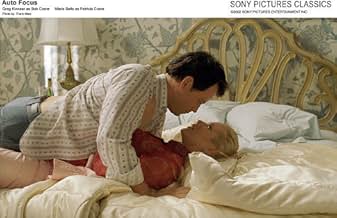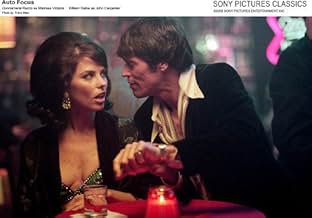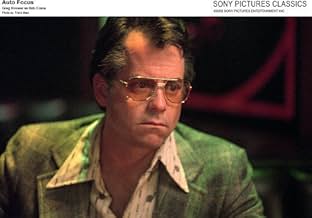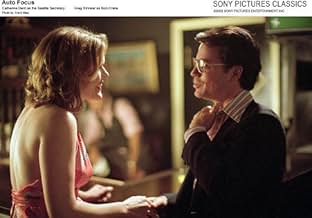Das Leben des Fernsehstars Bob Crane und seine seltsame Freundschaft mit dem Elektronikexperten John Henry Carpenter.Das Leben des Fernsehstars Bob Crane und seine seltsame Freundschaft mit dem Elektronikexperten John Henry Carpenter.Das Leben des Fernsehstars Bob Crane und seine seltsame Freundschaft mit dem Elektronikexperten John Henry Carpenter.
- Regie
- Drehbuch
- Hauptbesetzung
- Auszeichnungen
- 6 Nominierungen insgesamt
- Richard Dawson
- (as Michael Rodgers)
- Melissa
- (as Donnamarie Recco)
- …
Empfohlene Bewertungen
The movie hints very strongly that the killer was Bob Carpenter, played here by Willem Dafoe. Carpenter was a close friend of Crane's. Greg Kinnear does a credible job of portraying the television star.
However, the part about Crane's murder is only dealt with in the final minutes of the film! That was very disappointing and I was hoping to find out something or at least be given more information. They just kind tacked this on the end of the film.
Most of the film was about Crane's and Carpenter's escapades with women.....lots of women, beautiful and big-chested women, which you see in abundance in this film. Dafoe is the sleazy friend who introduces Crane to the beginning of the VCR age. That led to a whole bunch of sex-on-film and really whetted Crane's big sexual appetite.
Anyway, for people who watched "Hogan's Heroes," and there were plenty, this is a bio of him and perhaps, for those who know nothing about his death, who killed him.
Greg Kinnear taps into Bob Crane, though, from the first frame.
The viewer learns that the pre-Hogan Crane was an affable, lovable kind of guy whose LA radio show had a big following. His agent sees him as a combination of Jack Lemmon and Jack Benny, a potential star of fluffy sex comedies with a benign sort of sex appeal and a knack for snappy one-liners All of that was a vast overestimation of Crane's talents.
Crane reveled in the fame that "Hogan" brought him, but he seems never to have taken a long view of his career. When the show ended he was left rudderless and idle, having slowly cut the ties that bound him to ordinary life -- his work, a stable home life, and his religious faith.
While he coasted, Crane took advantage of the easy, cynical charm he conveyed on screen to lure women. By the dozen. I think he probably enjoyed being the least likely man in Hollywood to skulk strip clubs looking for prey, and to devote thousands of yards of videotape to his exploits with them. But his naivete is telling: Crane allows himself to be led into a netherworld by John Carpenter, (Willem Dafoe), who teaches him that putting sex on film is more fun than having it. And there is a brief scene where Crane meets a dominatrix and reveals himself as not quite savvy enough to play this game to win.
Addictions tend to claim those who are on the way up or the way down. Even before Peg Entwistle famously jumped off the Hollywoodland sign in 1922, there have been scores of aspirants to fame or has-beens whose compulsions have killed them, leaving their work on screen the least compelling,least-remembered part of their lives.
Greg Kinnear is definitely in one of his best parts here, as he plays someone who is an actor who keeps his actor-like charms off the set as well. In Hollywood, away from the confines of Connecticut, his Bob Crane lands the lead on Hogan's heroes, but can't resist the first temptations of the night-life. This comes, in an introductory way and then throughout as a tag-along/counterpart, with John Carpenter (not the director, played with the best match by Willem Dafoe of being a creep and alluring at times), who shows him the ropes and hooks him up with video equipment. But as Crane goes deeper into his sexual drives, divorces, marries again and divorces again, his acting career and his livelihood seem to slip away. The themes of being perversely the 'All-American Male' are accentuated by Kinnear's Crane in voice-over as he talks about the unbridled joys of sex, and in an interview with a Christian publication he says 'I don't...make waves'. By the last third of his story, however, into the rot of the 70s, he's lost touch with the reality of his pleasures- or rather necessities.
Auto Focus isn't at times an easy movie to sit through; it's even cringe-worthy in a couple of scenes (notably for me was when he guest stars on a celebrity cooking show, only to keep on his sexually-driven side with audience members). Then there are other scenes (i.e. 'you have fingers up you-know-where', and the genital enhancement) where male masculinity is questioned, and in very peculiar ways between Crane and Carpenter; Crane is homophobic, but then what exactly is Carpenter's function? More than anything, less than being a friend, he becomes a kind of unintentional pusher, where the draw of going out on the town becomes a crux for both of the men. What's just as fascinating then is how Schrader aligns this with his style- the first half is mostly very slick and professional-looking, almost like an HBO bio-pic or something. But then as the characters lose a grip on everything except themselves, there's a hand-held, distorted view to everything. There's lots of nudity and on-screen sex (some blurred out, likely by MPAA request), yet Schrader gets something more shocking, in the mind at least, as Carpenter almost becomes the antagonist in a way as the story winds down (the last phone call marks this most).
Auto Focus has the ideal of the usual biographical drama of a somebody in Hollywood who soon loses himself to becoming a nobody, but there's plenty under the surface that makes it more intriguing. Crane's two sides to his persona- the celebrity one, and the personal 'lifestyle' one- become one and the same after a while, Kinnear being able to make such a near-irredeemable person somewhat sympathetic (or at the least very watchable). And Carpenter's more truthful, emotional, and scary turn is made palatable by Dafoe's equally nuanced performance. It's not great, but it's a near-classic of the tale-of-such-and-such-star when so many don't take in what's deeper into account. A-
Wusstest du schon
- WissenswertesThe leather jacket that Greg Kinnear wears while playing Bob Crane in the Ein Käfig voller Helden (1965) scenes of this movie is the one that the real Crane actually wore during the filming of that TV series. Crane's son Robert David Crane loaned the jacket to Kinnear for this movie. Prior to the original "Hogan's Heroes" show, Frank Sinatra wore this exact same jacket in Colonel von Ryans Expreß (1965).
- PatzerThere is a glimpse of the famous Capitol Records building painted silver. At the time of the film, it was actually painted black to resemble a stack of records.
- Zitate
Bob Crane: I think it's perfect for me. I mean, this character Hogan, he's quick on his toes, he's hip, he's a con artist. I don't wanna jinx it, but I think it's what I've been working toward my whole career!
Anne Crane: Really? You've been working towards a Holocaust comedy?
Bob Crane: Ann!
Anne Crane: What, Bob?
Bob Crane: Please, not in front of the children! They look up to me!
Anne Crane: They're small. They look up to everyone.
- Alternative VersionenThe following deleted scenes appear on the DVD:
- Victoria finds Bob's body.
- Hogan's Heroes Montage
- Bob unloads drums and some dirty magazines fall out.
- Anne and Bob talking by the pool.
- Anne in the darkroom.
- VerbindungenFeatured in Auto Focus: Featurette (2002)
- SoundtracksSnap!
Written by Paul Schrader and Angelo Badalamenti
Performed by David Johansen (as Buster Poindexter)
Produced by Brian Koonin
Top-Auswahl
- How long is Auto Focus?Powered by Alexa
Details
- Erscheinungsdatum
- Herkunftsland
- Offizieller Standort
- Sprache
- Auch bekannt als
- Autofocus
- Drehorte
- Produktionsfirmen
- Weitere beteiligte Unternehmen bei IMDbPro anzeigen
Box Office
- Budget
- 7.000.000 $ (geschätzt)
- Bruttoertrag in den USA und Kanada
- 2.063.196 $
- Eröffnungswochenende in den USA und in Kanada
- 123.761 $
- 20. Okt. 2002
- Weltweiter Bruttoertrag
- 2.704.951 $
- Laufzeit
- 1 Std. 45 Min.(105 min)
- Farbe
- Sound-Mix
- Seitenverhältnis
- 1.85 : 1









































